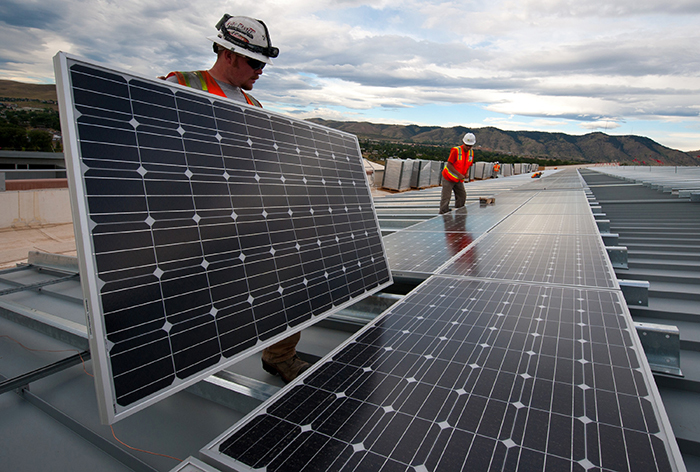Creating solutions: Energy
28 September 2015 | Compiled Abigail Calata.
Since 2008, South Africa's energy sector has been battling an energy crisis, with the state‑owned power utility Eskom struggling to match supply and demand. UCT engineers are hard at work finding solutions to the myriad problems that plague the sector and threaten the livelihood of all South Africans.
UCT's Department of Mechanical Engineering is home to two of the specialisation centres linked to the Eskom Power Plant Engineering Institute (EPPEI).
Established in 2012, EPPEI sees Eskom, the state‑owned power utility, partner with six leading South African universities to align their research with its needs. At UCT's specialisation centres, students embark on postgraduate studies guided by an industrial mentor and academic supervisor.
In the initial phase, only Eskom engineers with a bachelor's degree and two to four years' experience at the power utility are qualified to enter the programme. Presently, under certain conditions, Eskom bursars can join the programme on completion of their graduate studies. Initially, prospective students also had to complete courses at the Eskom Academy of Learning in the year before they registered at university; at present some are exempted from such courses.
Energy efficiency
The Eskom Specialisation Centre in Energy Efficiency aims to improve the availability, reliability and environmental impact of Eskom power plants by increasing the efficiency of energy production. "Students' research is focused on modelling the fluid flow processes that happen at power stations," says Dr Wim Fuls, who heads up this centre.
"Load shedding happens when plants break down and are not available to generate electricity due to age, poor maintenance and poor flow control, among other reasons. We're trying to solve this unavailability problem by modelling the plant process flow," he explained.
The Specialisation Centre in Material Science resides at UCT's Centre for Materials Engineering (CME) and is concerned with the engineering materials (mainly steels) used for components at power plants.
"Power generating plants operate under highly demanding conditions that include high temperature, high stress, a corrosive environment and a complex mechanical wear environment. At its most basic, power plant reliability is critically dependent on the integrity of a broad range of engineering materials that make up the structures, machines and systems within the plant," says CME director Prof Rob Knutsen.
"Advances in technology have allowed engineers to operate plants beyond their design life, but there is still considerable opportunity to improve equipment life prediction and monitoring, so as to optimise life extension and maintenance decisions.
"New materials development is required to handle increasingly challenging conditions, and the South African power industry must be developed to manage the use of new materials during design, construction, operation and plant maintenance," says Knutsen.
More than 15 students are currently working on research at the energy efficiency centre, with eight engaging in research at the CME. The target for all eight EPPEI Specialisation Centres is for an annual intake of 60 engineers.
It is envisaged that this skills development programme will be extended to benefit not only other players in the South African energy industry, but the rest of Africa since Eskom accounts for 40% of the power generated on the continent.
A catalyst for more power
UCT's Department of Chemical Engineering hosts one of the Hydrogen South Africa (HySA) centres of competence – HySA Catalysis.
Led by Sharon Blair, HySA Catalysis – in partnership with Mintek, the South African national mineral research organisation – develops materials and components in the early part of the fuel cell and hydrogen generation value chain.
A fuel cell is an energy converter that uses the chemical energy stored in hydrogen or another fuel to produce electricity cleanly and efficiently. Fuel cells are being used for several applications, ranging from automotive power trains to stationary off‑grid, back-up power generators for telecom towers, hospitals, rural schools and mobile clinics. A key component of fuel cells is platinum.
South Africa supplies some 80% of global platinum demand, and the HySA programme, established in 2008, aims to move the country from being a mere supplier of raw platinum to a manufacturer of value‑added components.
"HySA's main goals are to develop local expertise, knowledge, human capital and skills within fuel‑cell and hydrogen platinum group metals (PGM) catalyst technologies; and through that capture 25% of the world's fuelcell catalyst market by 2020," explains Blair.
"We also want to be recognised internationally as a fuel cell and hydrogen research institute. More importantly, we want to develop a pool of South African engineers and scientists for the fuel cell industry," she says.
Since 2010, HySA Catalysis has developed competitive technologies for current fuel‑cell markets, namely a platinum‑coated fuel‑cell catalyst.
To commercialise its technologies, HySA Catalysis established HyPlat (Pty) Ltd – a company 100% owned by UCT – in 2014. HyPlat will initially seek to establish itself as a supplier of quality catalysts to component developers and manufacturers, with a product range that either matches or exceeds the performance of any other catalyst on the market.
The future for the international fuel‑cell market looks bright. There is a growing demand for fuel cells in the global telecoms and automotive industries. Anglo American 2013 forecasts for PGM volume requirements for fuel cells are as high as 595 tons by 2050. This represents massive opportunities in mining, manufacturing and employment for South Africa.
Renewable energy
A focal research area for UCT's Energy Research Centre (ERC) is renewable energy, and in this vein the centre is investigating how renewable energy resources could be exploited in hybrid gas turbines.
"There is enormous potential for exploiting renewable energy resources to drive gas turbine power plants in the country, with solar energy being the most promising," says Dr Amos Madhlopa, ERC's group leader in renewable energy.
ERC findings show that solar-driven turbines have the greatest potential to generate electricity efficiently. Eskom's emergency turbines run mainly on diesel, with the bill to keep them going coming to R2 billion a month.
A basic gas turbine comprises a compressor, combustion chamber, turbine and generator. Air enters the compressor, and is compressed to higher pressure and temperature levels at the exit of the compressor. Fuel is mixed with the compressed air and then burnt in the combustion chamber. The expanding gas mixture drives the turbine, which in turn propels the generator. The exhaust energy from a simple gas turbine can be recovered and input to a steam turbine thereby forming a combined‑cycle gas turbine. Combining a simple gas and a steam turbine increases the energy efficiency of the system.
"The intermittent nature of renewable energy resources such as wind and solar radiation is one reason for investors to prioritise investment in conventional energy sources such as coal and diesel. However, the hybridisation of two or more energy sources could assist in overcoming this problem of resource intermittency," says Madhlopa.
Economically viable
Over the past four years, renewable energy has proven its ability to contribute positively to the South African economy in the short term.
The Council for Scientific and Industrial Research (CSIR) found that in 2014, renewable energy resources contributed R800 million net benefit to the economy. In the same year wind and solar photovoltaic (PV) cells, which convert solar energy to electricity, helped to avoid load shedding on 15 days. Furthermore, between November 2011 and August 2014 tariffs for solar PV cells dropped from R3.44 to 82c per kWh, and from R1.42 to 65c per kWh in the case of wind.
"While the ERC consistently pursues research into longer-term outlooks, possibilities and constraints, it remains mindful of the urgency for supplying energy security. Renewable energy is clearly proving its ability to contribute positively in this area."
ERC is a multi‑disciplinary centre widely recognised for the positive contribution it makes to a deeper understanding of issues of energy and development in South Africa, sub‑Saharan Africa, the Global South and across the world.
 This work is licensed under a Creative Commons Attribution-NoDerivatives 4.0 International License.
This work is licensed under a Creative Commons Attribution-NoDerivatives 4.0 International License.
Please view the republishing articles page for more information.
Faculty Focus - Engineering & the Built Environment
Opinions
Feature
Front page
Previous Editions











